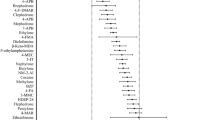Abstract
Nicotinic acetylcholine receptors (nAChRs) belong to the Cys-loop receptor family and are important drug targets for the treatment of neurological diseases. However, the precise determinants of the binding efficacies of ligands for these receptors are unclear. Therefore, in this study, the binding energy profiles of various ligands (full agonists, partial agonists, and antagonists) were quantified by docking those ligands with structural ensembles of the α7 nAChR exhibiting different degrees of C-loop closure. This approximate treatment of interactions suggested that full agonists, partial agonists, and antagonists of the α7 nAChR possess distinctive binding energy profiles. Results from docking revealed that ligand binding efficacy may be related to the capacity of the ligand to stabilize conformational states with a closed C loop.





Similar content being viewed by others
References
Taly A, Corringer PJ, Guedin D, Lestage P, Changeux JP (2009) Nat Rev Drug Discov 8:733–750
Lester HA, Dibas MI, Dahan DS, Leite JF, Dougherty DA (2004) Trends Neurosci 27:329–336
Levin ED, Rezvani AH (2007) Biochem Pharmacol 74:1182–1191
Arneric SP, Holladay M, Williams M (2007) Biochem Pharmacol 74:1092–1101
Seguela P, Wadiche J, Dineley-Miller K, Dani JA, Patrick JW (1993) J Neurosci 13(2):596–604
Martin LF, Kem WR, Freedman R (2004) Psychopharmacology 174:54–64
Collins AC, Marks MJ (1991) J Addict Dis 10(1–2):109–126
Morales-Perez CL, Noviello CM, Hibbs RE (2016) Nature 538:411–415
Brejc K, van Dijk WJ, Klaassen RV, Schuurmans M, van der Oost J, Smit AB, Sixma TK (2001) Nature 411:269–276
Hansen SB, Sulzenbacher G, Huxford T, Marchot P, Taylor P, Bourne Y (2005) EMBO J 24:3635–3646
Brams M, Pandya A, Kuzmin D, van Elk R, Krijnen L, Yakel JL, Tsetlin V, Smit AB, Ulens C (2011) PLoS Biol 9:e1001034
Liu X, Xu Y, Li H, Wang X, Jiang H, Barrantes FJ (2008) PLoS Comput Biol 4:e19
Cheng X, Wang H, Grant B, Sine SM, McCammon JA (2006) PLoS Comput Biol 2:e134
Hibbs RE, Sulzenbacher G, Shi J, Talley TT, Conrod S, Kem WR, Taylor P, Marchot P, Bourne Y (2009) EMBO J 28:3040–3051
Torrie GM, Valleau JP (1977) J Comput Phys 23:187–199
Ulens C, Hogg RC, Celie PH, Bertrand D, Tsetlin V, Smit AB, Sixma TK (2006) Proc Natl Acad Sci USA 103:3615–3620
Yu R, Craik DJ, Kaas Q (2011) PLoS Comput Biol 7:e1002011
Webb B, Sali A (2016) Curr Protoc Protein Sci 86:2.9.1–2.9.37
Yu R, Tabassum N, Jiang T (2016) Bioorg Med Chem Lett 26:1296–1300
Li SX, Huang S, Bren N, Noridomi K, Dellisanti CD, Sine SM, Chen L (2011) Nat Neurosci 14:1253–1259
Suresh A, Hung A (2016) J Mol Graph Model 70:109–121
Trott O, Olson AJ (2010) J Comput Chem 31:455–461
Kitchen DB, Decornez H, Furr JR, Bajorath (2004) J Nat Rev Drug Discov 3:935–949
Huang X, Zheng F, Zhan C-G (2008) J Am Chem Soc 130:16691–16696
Hibbs RE, Sulzenbacher G, Shi J, Talley TT, Conrod S, Kem WR, Taylor P, Marchot P, Bourne Y (2009) EMBO J 28:3040–5125
Spurny R, Debaveye S, Farinha A, Veys K, Vos AM, Gossas T, Atack J, Bertrand S, Bertrand D, Danielson UH (2015) Proc Natl Acad Sci USA 112:E2543–E2552
Acknowledgments
We are grateful to Prof. Philip Biggin for his comments about this manuscript. This work was supported by grants from the Natural Science Foundation of China (NSFC) (no. 81502977), the China Postdoctoral Science Foundation (861505020050 and 2016 T90655), and the Special Foundation for Qingdao Basic Research Program (15-9-1-85-jch). The authors gratefully acknowledge the funding from the above sources.
Author information
Authors and Affiliations
Corresponding author
Electronic supplementary material
Figure S1
The opening distances of the C-loop of AChBP bound to full agonists (“agonists” in the figure), partial agonists, and antagonists of α7 nAChR (data are for the relevant crystal structures). When AChBP is bound to full agonists (PDB ID: 2BYQ, 2WNL), the C loop is more closed than when AChBP is bound to partial agonists (PDB ID: 4AFH, 2WNC, 2WNJ, 2WN9) and antagonists (PDB ID: 2XYS, 2XYT). Overall, the C-loop opening distance increases in the following order: full agonists < partial agonists < antagonists. (DOC 8732 kb).
Rights and permissions
About this article
Cite this article
Tabassum, N., Ma, Q., Wu, G. et al. Exploring the binding energy profiles of full agonists, partial agonists, and antagonists of the α7 nicotinic acetylcholine receptor. J Mol Model 23, 251 (2017). https://doi.org/10.1007/s00894-017-3419-4
Received:
Accepted:
Published:
DOI: https://doi.org/10.1007/s00894-017-3419-4




